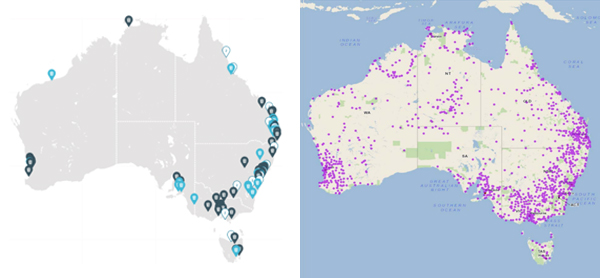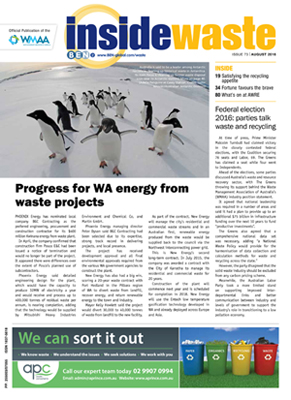The changing climate of waste
By Julien Gastaldi – Business Development Manager, MRA Consulting Group
Climate policy is still lagging behind …
At the time of writing, it is still not known who has won the federal election. Climate change has been relatively low profile compared to previous election campaigns and – paradoxically – this is good news. It is both a sign of maturity (the main parties have stopped arguing about the “crap” science of climate change) and an early sign of a possible return to bi-partisanship.
This election was the last chance to shape Australia’s response to the “Critical Decade” identified by the Climate Council in 2010 – when we discovered that we only have a finite “carbon budget” that we can use. Beyond that budget, we start ratcheting up GHG debt and heading into dangerous climate change territory.
One of the key findings at the time was that under any scenario, Australia should reach ‘Net Zero’ Emissions by 2050. Judging by the main parties’ GHG emissions targets summarised in the table below, we are still missing the mark.
Table 1. 2016 Election commitments
| Party | Target by 2030 | ‘Net Zero’ target | Warming if matched by other countries |
| Coalition | -28% | 2050-2100 | 3-4˚C |
| Labour | -45% | 2050 | 2-3˚C |
| Greens | -63 – 82% | 2040 | 1.5-2˚C |
| Nick Xenophon | -55% | – | 2-3˚C |
The iconic photographs of an in-ground swimming pool stranded on a Collaroy Beach, or an unearthed landfill on the central coast last month are a stark reminder of what severe storms and king tides can and will do to our coastline with ongoing sea level rise. The Insurance Council of Australia, has said that Australia’s East Coast storms resulted in an estimated damage bill of $235 million.
The Commonwealth Government’s National Coastal Vulnerability Assessment (2009) (of which Mike Ritchie was a part author) warned that 157,000 – 247,000 individual residential buildings are at risk with a sea level rise of 1.1 metres by 2100. The damage to housing alone was estimated at $63bn. A follow up report in 2011 into commercial buildings, industrial precincts and transport infrastructure found a further $226bn in coastal assets at risk.
A total of $289 billion in infrastructure losses: this dwarfs the actual $28.6bn in costs damage bill from all major floods, tropical cyclones and severe storms that occurred between 1967 and 1999.
As Australia continues to delay meaningful action, we are heading for a steep step change in emissions around 2030 if we are to meet our 2degrees target. For example, Figure 1 provides a clear illustration of this step change effect: the longer we wait, the bigger the step and the harder the transition will be.
Change is inevitable – but it also offers great opportunities.
Figure 1. Reducing Emissions earlier lessens disruption and risks of future transition – Source: modified form Climate Change Authority 2012 recommendations

… But getting back on track has never been so easy
Whatever the election result, the minor parties will almost certainly have the balance of power in the Senate. The two main parties that will influence the passage of climate policies are the Greens and the Nick Xenophon team. Therefore we would expect that the 2017 review of the ERF will trigger changes in the policy framework towards stronger action.
A price on carbon under a cap and trade mechanism is still the most efficient way to achieve emissions (because polluters who can reduce emissions most cheaply will do so, achieving a regulated emission reduction target at the lowest cost to society).
The Safeguard Mechanism limits the emissions of the “big emitters” (about 340 companies with emissions greater than 100,000 tCO2-e/yr.) and has legal controls and penalties if they breach a set cap. They can trade excess emissions to other liable entities.
It looks and behaves a lot like emissions trading. With two minor tweaks the Direct Action Safeguard Mechanism could be converted to a viable carbon pricing mechanism:
- Increase the coverage to include most large emitters say > 25,000 tCO2-e/yr
Like many others we do not think this should include landfills unless the government agrees to finally using a simple proxy of emissions. The costs of carbon accounting and the errors associated with it, under the old scheme, were simply ridiculous. But ultimately, it will be a decision for government whether to follow ALOA’s recommendation to keep the waste industry out of a new emissions trading system – and follow the US EPA in relying on best practice regulation and minimum regulatory standards. - Revise the “Baselines” (which are the upper limit emitters must not cross) downwards over time
These are currently weak and based on the highest level of historical emissions for the period 2009/10 – 2013/14.
Direct Action in the waste industry to date – a success but we can do much more
Under the current Direct Action policy, Australian Carbon Credit Units (ACCU’s) are currently worth $10.23 (average price at the last auction), and can be produced using one of the three waste methods: landfill gas, mixed waste to AWT and source separated organics diversion.
Our industry can also tap into the soil carbon, energy efficiency and whole-of-facility NGER methods.
There are currently 125 waste projects registered – 85 of which have secured a contract with the Clean Energy regulator to sell their ACCUs at a known price and volume for 7 years.
Together these projects have since 2012 produced almost 11 MtCO2-e of certified emission reductions. That’s about 2% of Australia’s annual emissions of about 530 MtCO2-e, and more than the waste sector’s entire annual emissions (currently at 9 MtCO2-e each year – Figure 2).
Figure 2. Emissions from solid waste disposal, 1990 – 2014

The other 40 registered projects – as well as the hundreds of other waste sites with no registered projects (665 operating landfills in Australia according to DEWHA, 2009 – see Figure 3) – have no or little incentive to reduce their emissions beyond business as usual.
For example, diverting a tonne of organic waste from landfill is worth about $6/t of waste (taking into account the MSW emissions factor of about 1.2 tCO2-e/t and an average ‘whole of life’ landfill gas capture rate of 50%). This is not a big financial incentive for investors, bearing in mind that landfill levies alone in most States range from $50-135.70/t of waste. A carbon price of $6/t (of waste) is a long way from being a lever of change. It is extra cream if a project is viable anyway.
Another example is the absence of landfill gas capture and destruction systems on most small, regional and/or closed landfills, with capital costs of at least $200,000 per project for a few gas wells, a flare and compliant monitoring equipment. The ERF returns alone rarely justify the infrastructure and administration costs.
But there is progress in that space: having captured all the low hanging fruit, the LFG industry is now developing new business models to expand to smaller sites. The regulators (e.g. through the new Solid Waste Guidelines in NSW) and the landfill industry are taking steps towards the harmonisation of ‘best practice’ regulations.
The ERF funding (or any other mechanism to reward abatement under an ETS) will be key in making these projects happen.
Figure 3. Location of the current 125 ERF waste projects as presented by CER (2016) compared to the distribution of all landfills in Australia

Pathways to zero net emissions by 2050 – How can the waste industry prosper in a ‘Net Zero’ emissions Australia?
The waste sector can still lead the charge on Emissions Reduction efforts.
We could be providing ‘Net Zero’ services well before 2020, as we continue to generate more ACCUs than tCO2-e of methane that we emit. What’s more we are doing so using the well-regulated and credible offset framework that is the ERF.
We are not merely reducing emissions – we are doing so at scale, in private-public partnerships and under scrutiny from external auditors.
This is an Australian first and a little-known fact that we should promote better.
ClimateWorks Australia and the Australian National University (ANU) were recently appointed to lead Australia’s participation in the global 2050 Deep Decarbonisation Pathways Project and figure out how Australia can prosper in a low carbon world.
They find that Australia can achieve ‘Net Zero’ emissions by 2050 and live within its recommended carbon budget, using technologies that exist today by relying on four pillars: ambitious energy efficiency; low carbon electricity; electrification/fuel switching; and reducing non-energy emissions in industry and agriculture. Climate works believes that our emissions could be reduced from current levels down to about 160MtCO2-e/yr. – meaning we need to build a new abatement industry capable of creating 160,000,000 ACCUs every year.
The landmark report makes no mention of the role that waste could play on each of these 4 pillars, but we do have a role in assisting other sectors of the economy reach their ‘Net Zero’ position.
The waste and resource recovery industry can provide additional, above and beyond abatement. We can provide zero-carbon electricity, zero-carbon heat, renewable fuel, energy from waste, vehicle emissions fleet management, carbon capture and sequestration to soil, help trigger behaviour change – using proven and reliable technology.
According to analysis undertaken recently by MRA, our sector could provide 35-41 MtCO2-e of abatement each year at a low cost of about $10/ACCU thanks to the support form waste levies and grants. This abatement potential will grow rapidly as waste generation grows by about 7% each year.
The industry’s 40MtCO2-e/yr abatement potential represents more than 7.5% of Australia’s current total emissions – and could amount to as much as a third of the ongoing 160MtCO2-e/yr. abatement we will need to produce post 2050. We are the key to achieving ‘Net Zero’ once all other industries have reduced their emissions as far as feasible.
Next steps
As an industry, we need to come together to clarify our role, our vision and claim back our once leading position in the production of ACCUs. The next steps our sector needs to take next are:
- Agree on a vision for the sector towards ‘Net Zero’ – and its role in assisting other sectors to reach that goal.
- Promote it to regulators, and other sectors of the industry.
- Get the industry’s abatement potential formally recognised by increasing the number of registered ERF projects. The source separated method is under-subscribed and good low-flow low-landfill-gas-quality flares are now available. If you are planning to carry out any of the projects listed here within the next 5 years, you should register your project with the CER now – before you start – to avoid the risk of breaching the newness requirement.
- For those ready to commit to deliver a fixed volume of abatement at a fixed price, the next and probably last opportunity to secure an ERF Carbon abatement Contract is expected this November;There is a role for current participants, local and state government in assisting with the uptake (e.g. publish case studies and business cases).
- Actively participate in the design of the next scheme or policy.
As always, we welcome your feedback on this, or any other topic on ‘The Tipping Point’.
This article has been published by the following media outlets:
 Inside Waste, Issue 73, August 2016 (click to view)
Inside Waste, Issue 73, August 2016 (click to view)



